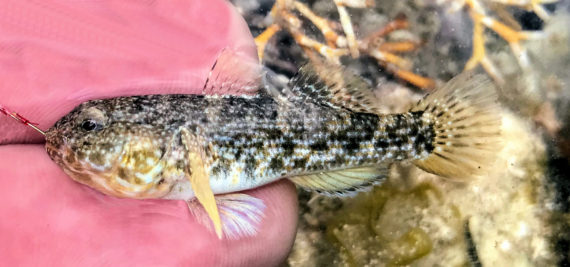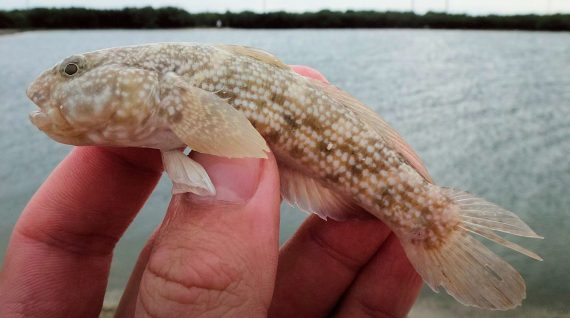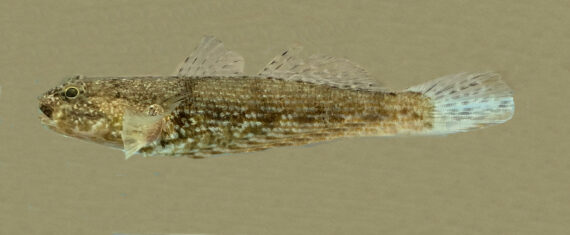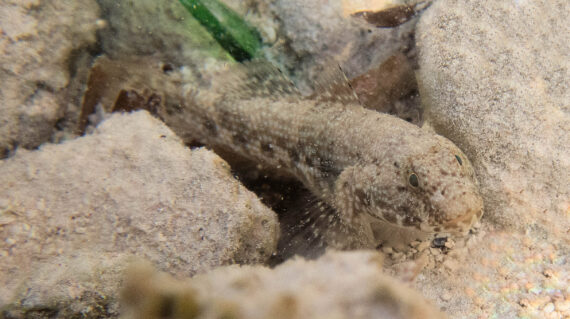Checkerboard Frillfin, Bathygobius lacertus
 Checkerboard Frillfin, Bathygobius lacertus. Fish caught from coastal waters off Conzumel, Quintana Roo, May 2018. Length: 7.1 cm (2.8 inches). Catch, photograph, and identification courtesy of Ryan Crutchfield, Tampa, Florida.
Checkerboard Frillfin, Bathygobius lacertus. Fish caught from coastal waters off Conzumel, Quintana Roo, May 2018. Length: 7.1 cm (2.8 inches). Catch, photograph, and identification courtesy of Ryan Crutchfield, Tampa, Florida.
 Checkerboard Frillfin, Bathygobius lacertus. Fish caught from coastal waters off Sugarloaf Key, Florida, December 2013. Length: 10.3 cm (4.1 inches). Catch, photograph, and identification courtesy of Ben Cantrell, San Diego, California.
Checkerboard Frillfin, Bathygobius lacertus. Fish caught from coastal waters off Sugarloaf Key, Florida, December 2013. Length: 10.3 cm (4.1 inches). Catch, photograph, and identification courtesy of Ben Cantrell, San Diego, California.
 Checkerboard Frillfin, Bathygobius lacertus. Fish caught from coastal waters off Missouri Key Key, Florida, July 2020. Length: 10.3 cm (4.1 inches). Catch, photograph and identification courtesy of Luke Ovgard, Klamath Falls, Oregon.
Checkerboard Frillfin, Bathygobius lacertus. Fish caught from coastal waters off Missouri Key Key, Florida, July 2020. Length: 10.3 cm (4.1 inches). Catch, photograph and identification courtesy of Luke Ovgard, Klamath Falls, Oregon.
 Checkerboard Frillfin, Bathygobius lacertus. Underwater photograph taken with coastal waters off Cozumel Island, Quintana Roo, March 2021. Photograph and identification courtesy of Marina Sutormina, Stockholm, Sweden.
Checkerboard Frillfin, Bathygobius lacertus. Underwater photograph taken with coastal waters off Cozumel Island, Quintana Roo, March 2021. Photograph and identification courtesy of Marina Sutormina, Stockholm, Sweden.
The Checkerboard Frillfin, Bathygobius lacertus, is a member of the Goby or Gobiidae Family, that is also known as the Checkerboard Frillfin Goby and in Mexico as gobio tablero. Globally, there are twenty-sven species in the genus Bathygobius, of which five are found in Mexican waters, four in the Atlantic and one in the Pacific Ocean.
The Checkerboard Frillfin has a robust body. They are a grayish brown color with the upper body having three indistinct dark saddles and a fourth saddle at the end of the caudal peduncle. The lower body has a checkerboard pattern with 2 rows of 6 or 7 offset blotches. The lower row of blotches is more diffuse than the upper row. The caudal fin has a narrow, short dark bar at its base and thin dark bars toward the otter margins, the first dorsal fin has 1 to 4 horizontal lines of dark spots across the fin; and, the second dorsal has thin dark stripes. Their head is broad with pores, a bluntly rounded snout, large eyes that are set close together and a modest sized mouth with teeth set in bands. Their anal fin has 1 spine and 8 rays; their caudal fin is rounded; their dorsal fin has 7 spines and 9 rays; their pectoral fins have 18 to 20 rays and the first 3, 4 or 5 are free standing and elongated extending to the rear margin of the first dorsal fin; and, their pelvic fins are fused into a disc and do not reach the anus. They are covered with large rough scales. They do not have a lateral line.
The Checkerboard Frillfin is a small shallow-water benthopelagic species found in a wide variety of habitats including sheltered and exposed rocky and sandy environments and within mangrove roots at depths up to 3 m (10 feet). They reach a maximum of 10.3 cm (4.1 inches) in length. The Checkerboard Frillfin is poorly studied with very limited information available about their lifestyle and behavioral patterns including specific details on age, growth, longevity, movement patterns, diet, habitat use, and reproduction.
The Checkerboard Frillfin is a resident of Mexican waters of the Atlantic Ocean but is only found along the east coast of the Yucatán Peninsula in the Caribbean; they are absent from the Gulf of Mexico.
The Checkerboard Frillfin can be confused with the Frillfin Goby, Bathygobius soporator (6 or 7 large wide bars dorsally), the Island Frillfin, Bathygobius mystacium (1 row large square blotches below mid-body) and the Notchtongue Goby, Bathygobius curacao (lack a distinct color pattern).
From a conservation perspective the Checkerboard Frillfin is currently considered to be of Least Concern with stable, widely distributed populations. Due to their small size they are of limited interest to most.